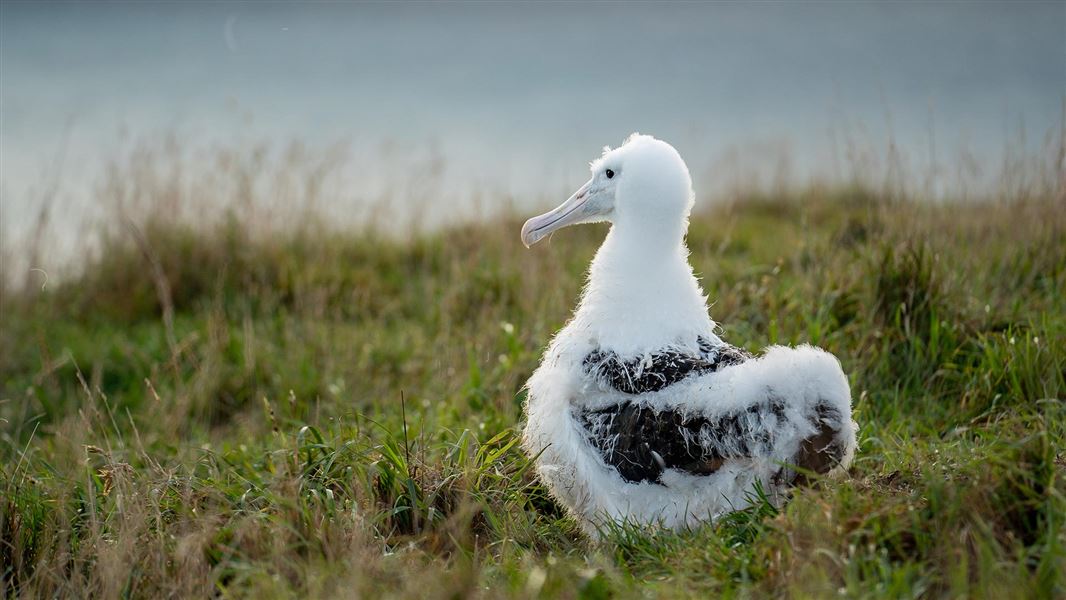Archived content: This media release was accurate on the date of publication.
Date: 24 October 2024
Thirty-three chicks have successfully fledged from the colony and will now spend the next four to ten years at sea, before returning to Pukekura to breed.
Department of Conservation Coastal Otago Ranger Sharyn Broni says it was a fantastic breeding season, equalling last year for the most chicks successfully fledged in a season.
“A lot of effort goes into managing the colony to give toroa the best chance of success so it’s really rewarding to see another year of strong breeding.
“For example, this year, rangers fed an orphaned chick five times a week for more than four months after both of its parents did not return to the headland. This required over 100 kg of fish and squid to sustain the chick at a healthy weight.
Other work the rangers carry out includes weighing and monitoring chicks and supplementary feeding for those that are underweight, Sharyn says.
“We’re also researching where the fledging toroa go with two types of trackers.
“Global Location Sensors (GLS) were fitted to 20 fledglings, to record location data for three years. GLS tags record ambient light level to determine the birds’ approximate location. The data is stored so we will recover it from the tags when the birds return to the colony in four to ten years.
“Global Positioning System tracking tags were fitted to another 10 fledglings, thanks to crowdfunding by the Royal Albatross Centre. These trackers are solar powered and give us accurate, real-time updates of the bird’s position for about a year. Some of this year’s fledglings have almost made it to South America already.”
This data will be used to assist with DOC’s bycatch mitigation programme. Understanding where the birds go allows us to assess their direct risk from fisheries bycatch and fisheries overlap.”
Sharyn Broni says sadly, plastic pollution is a significant threat to toroa as birds can mistake floating plastic for food and eat it or feed it to chicks.
“Earlier this year, a ten-day-old chick died after ingesting soft plastic regurgitated by its parent. It was the first time we lost a chick in this way.
“Staff also saw plastic in the regurgitations of several chicks this season which is a concern.”
Royal Albatross Centre Assistant Operations Laura Findlay says it’s been another great season for toroa at Pukekura, and visitors have enjoyed some excellent viewing watching the chicks grow into fully fledged birds.
“We enjoy working alongside the Department of Conservation and assisting them with their efforts to protect these threatened seabirds, particularly this winter with the orphaned chick that required regular supplementary feeds.
Thank you to all of our supporters and generous donors who have helped fund the tracking programme along with other running costs this season, it is greatly appreciated. Here’s to the next cohort!”
Sharyn Broni says the success at the colony is fantastic, but the toroa breeding there are only a small portion of the overall population, and the wider outlook for the species is challenging.
“These birds breed slowly and face a range of threats including climate change, plastic pollution and some fishing practices.”
DOC co-manages the albatross colony as part of Te Poari a Pukekura (the Pukekura Co-management Trust) alongside Te Rūnanga o Ōtākou, Korako Karetai Trust and Dunedin City Council, with the support of the Otago Peninsula Trust. The colony has grown from one breeding pair in 1937 to more than 60 pairs in 2024.
Anyone who wants to learn more about the species can tune into the round-the-clock livestream Royal Cam, which follows one toroa pair as they raise a chick from egg to fledging. The livestream is a collaboration between DOC and the Cornell Lab of Ornithology.
This year, two nests appeared on Royal Cam for the first time in the live stream’s nine-year history.
The designated Royal Cam chick was named Kiwa, which was chosen through the annual Name the Chick competition. Kiwa is named after a guardian of the ocean. He fledged on 23 September and has a GLS fitted.
Background information
Toroa/northern royal albatross are one of the largest seabirds in the world, with wingspans up to 3 m. They are a vulnerable species that has been affected by changes to habitat and climate and by some fishing practices.
They also reproduce slowly, with breeding pairs typically raising a chick once every two years.
The colony at Pukekura/Taiaroa Head is the only mainland site in the world where toroa/northern royal albatross breed.
A taonga species, toroa have a conservation status of ‘Nationally Vulnerable’, with an estimated population of about 17,000 mature individuals.
The Royal Cam livestream is run in partnership with Cornell University’s Lab of Ornithology in New York, helping the lives of these albatross reach an international audience. Each year it receives millions of views from people all around the globe.
Contact
For media enquiries contact:
Email: media@doc.govt.nz
